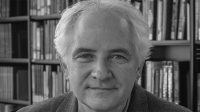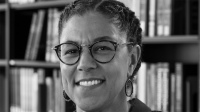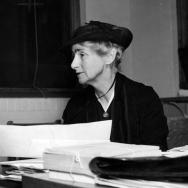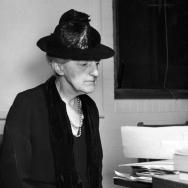Social work is a field of study and profession aimed at addressing problems in society—from educational inequality to health disparities to child and family welfare. Whether they practice directly with individuals or groups, organize community-based activities or lead policymaking efforts, social workers are committed to creating social change.
In 1920, Edith Abbott and Sophonisba Breckinridge founded one of the country’s first graduate schools of social work at the University of Chicago. Their bold vision emphasized the need for science and research as foundational elements in social change. Today, faculty and students at the Crown Family School of Social Work, Policy, and Practice continue this tradition by studying topics ranging from child welfare, criminal justice disparities, homelessness, health care, youth violence prevention, low-wage employment, immigration, and substance use and abuse.
What is social work?
Social work is a profession and academic discipline dedicated to addressing society’s tough issues and empowering the most vulnerable people.
“The mission of the social work profession is really to enhance social justice,” said social worker and Prof. Mark Courtney of the University of Chicago. “We’d like to think that, in all the areas that we work in, we’re focusing on the communities and populations that are most marginalized—that need the most help.”
Many of the social policies and safety nets essential to American life today—social security, child welfare and labor laws—are due to the efforts of social workers. Using a combination of social science research, theory and on-the-ground work directly within communities, social workers examine critical social problems to find the root causes.
What do social workers do?
The social work profession is incredibly diverse. A practitioner’s duties can range from directly serving individuals, to managing nonprofit organizations, to conducting research and lobbying for policy changes.
Some social workers engage in direct service—working directly with clients to assess their needs and direct them to the appropriate services. For example, a social worker could help someone struggling with substance abuse find a support group. Licensed clinical social workers can provide treatment. In fact, social workers are the largest mental health providers in the country.
Practitioners often work within existing institutions. “We find ourselves in settings like hospitals, and schools and attorney offices and mental health clinics, both as supports to those organizations and also as administrators of those organizations,” said UChicago Prof. Gina Miranda Samuels, a social worker who focuses her research on transracial adoption and foster care.
Other social workers focus on policy. Some researchers conduct studies to better understand an issue or evaluate how effective a particular policy is. Based on their findings, social workers can propose policy changes or advocate for new laws. They may be involved in writing grants or speaking directly to lawmakers.
For example, Crown Family School Prof. Susan Lambert studies how employer practices shape the lives of low-paid workers. Her research on the impact of precarious scheduling practices led to policy changes and laws regarding scheduling in hourly jobs.
In his Midwest Study, Mark Courtney followed the lives over 700 youths to determine what happens to young people who “age out” of foster care. His research was used as evidence to pass a federal bill giving states the option to extend care from 18 to 21.
What is the history of social work?
U.S. social work arose out of the Progressive Era, a period from the 1890s to 1920s in which the country experienced rapid social reform. During this time, a huge wave of immigrants arrived in the U.S. in search of new opportunities. As factories and new industries sprang up, those seeking employment flocked to cities. But the influx of people stretched city resources thin. Overcrowding, poverty and poor working conditions were on the rise.
Historically, helping vulnerable groups fell to religious organizations or charity groups. But in the late 19th century, social reformers began to create institutions like settlement houses and training schools dedicated to tackling these new social issues.
“During the Progressive Era, there’s concern about child labor. There’s also concern about working conditions generally: Should we have a 40-hour work week? Should there be public education?” Courtney said. “Reformers were saying: ‘There are things we can do through collective action. We need to act together.’”
However, institutions that provided aid—both religious and secular—were still segregated. To fill gaps where they’d been excluded, people of color helped their own communities through churches or other organizations. “There were mutual aid movements in the Black community with Black sororities led by Black women,” Miranda Samuels said. “There’s mutual aid in Indigenous communities, in Latinx communities. This has always existed."
What is a settlement house?
In cities like Chicago, settlement houses emerged in the late 1880s. These were physical spaces where mainly middle- and upper-class women lived and provided services to those in need, particularly new immigrants adjusting to American life. Some settlements were religious, but increasingly social reform was moving in a secular direction.
Hull House, founded by Jane Addams in 1889, was Chicago’s most famous settlement house.
The settlement provided essential services like kindergarten and public health programs. Its residents, which included Crown Family School founders Sophonisba Breckinridge and sisters Edith and Grace Abbott, went into the surrounding neighborhoods to understand how people actually lived.
“A lot of work that came out of Hull House was investigating public health problems. Why do we have disease? Well, because the poor neighborhoods have open sewage,” Courtney said. “A lot of early public health really was social work.”
The data they collected served as key evidence for local, then federal, changes regarding child welfare. Before 1899, children were tried and punished as adults. UChicago alum Grace Abbott would eventually join the U.S. Children’s Bureau, where she developed the first laws limiting child labor.
Inspired by Hull House, the Rev. Graham Taylor established the Chicago Commons Settlement House in 1894 on Chicago’s northwest side. To provide more professional training for the burgeoning field of social reformers, he established the Chicago School of Civics and Philanthropy in 1908. Edith Abbott served as its assistant director and Breckinridge headed the research department.
Social work was becoming more and more defined, with clear “experts” leading the field. “There’s a transformation in the teens, where there’s an active discussion at these meetings about social work: Are we a profession?” Courtney said. “By the end of the 1910s, you start to see the development of formal institutions.”
Edith Abbott was adamant that social work education should be conducted at the graduate level, under the sponsorship of a university. “Social work will never become a profession—except through the professional schools,” she once said. “A good professional school of social welfare not only needs a close connection with a good university but the modern university also needs such a school.”
Under Abbott and Breckinridge’s guidance, the Chicago School merged with the University of Chicago in 1920 establishing the Crown Family School (formerly known as the School of Social Service Administration) as one of the first social work schools in the country.
Who were the first social workers?
Learn more about a few of social work’s founding figures:
- Laws protecting immigrants from exploitation
- Preventing a literacy test requirement for entry into the country
- Enforcing the first federal child labor laws
- The passage of the Sheppard-Towner Act, which provided the first federal grants to aid the social welfare of children
- Helping draft the Social Security Act of 1935
Edith Abbott (1876-1957) was a social worker, economist and founder of one of the first social work schools in the country. Born to a family of activists in Grand Island, Abbott attended the University of Chicago for graduate school, receiving a Ph.D. in economics in 1905.
She became the assistant director of the Chicago School of Civics and Philanthropy, where she worked alongside Graham Taylor and Sophonisba Breckinridge. Living at Hull House, she was surrounded by the “Great Ladies of Halsted Street”—Jane Addams, Alice Hamilton, Florence Kelley, Julia Lathrop, and her own sister, Grace Abbott.
She, along with Breckinridge, paved the way for the School’s merger into the University of Chicago. In 1924, Abbott became its dean—the first female dean of any graduate school in the United States.
Her curriculum included legal concepts, the social implications of medical problems, and social administration. Edith Abbott’s own greatest contribution to public policy, her book Public Assistance—American Principles and Policies, was the product of many years of research and teaching.
Grace Abbott (1878-1939) was a social worker and political reformer who worked tirelessly to improve the lives of immigrants, children and women. The younger sister of Edith Abbott, Grace studied law at the University of Chicago and received a master’s degree in 1909. She lived at Jane Addams’ Hull House in 1908, and that same year became director of the Immigrants’ Protective League. In 1917, she moved to Washington to join the Children’s Bureau of the U.S. Department of Labor, and shortly thereafter became its chief.
Abbott pioneered the process of collecting and incorporating sociological data into the lawmaking process. Her leadership helped fund over 100 social research investigations, many of which were conducted by the Crown Family School (then called the School of Social Service Administration) where she held a professorship until her death.
During her career, she was responsible for:
Sophonisba Preston Breckinridge (1866-1948) was an educator, social reformer’, and lawyer who helped establish one of the first graduate programs for social work at the University of Chicago.
Born in Kentucky in 1866, Breckinridge was educated at Wellesley and later attended the University of Chicago where she became the first woman to earn a Ph.D. in political science. She then enrolled in the inaugural class of the University’s new Law School and, in 1904, became the first woman to earn a law degree there.
After graduation, Breckinridge was appointed a professor at the University in the Department of Household Administration, introducing courses on public institutional management and public institutions for children. She became a resident of Jane Addams’ Hull House, where she helped found the Chicago Women’s Trade Union League and the Chicago Chapter of the NAACP.
Breckinridge headed the research department at the Chicago School of Civics and Philanthropy and eventually led the Chicago School’s merger with the University of Chicago to become the Crown Family School (then called the School of Social Service Administration).
What impact has social work had on U.S. policy and culture?
Not only do social workers have a clear impact on the lives of the individuals they serve, but since the profession’s inception, their research and expertise have guided many U.S. policies. Many federal agencies, like the U.S. Children’s Bureau and the Administration for Children and Families, have been led by social workers.
“A lot of new ideas that end up percolating up into federal policy were ideas that social workers, because of their engagement and embeddedness in communities, came up with,” Prof. Courtney said.
The work of early social workers helped establish the safety net and social welfare systems that we may take for granted today.
For example, during her time at the U.S. Children’s Bureau, Grace Abbott was instrumental in enforcing the first child labor law passed in 1916 and issuing the first federal grants for the welfare of children and mothers in the U.S. The Abbott sisters and Breckinridge also helped draft the Social Security Act of 1935, which continues to provide social insurance for Americans of retirement age or with disabilities.
One of the architects of the New Deal was social worker Harry Hopkins (1890–1946). In the 1930s, the U.S. was plunged into the Great Depression and unemployment skyrocketed. To aid a struggling nation, President Franklin D. Roosevelt passed the New Deal—a series of relief programs aimed at getting people back to work. Hopkins supervised the Works Progress Administration (WPA), among others, which built thousands of parks, public buildings and roads across the country.
What are some key issues in the field of social work today?
The problems that early social workers sought to address—poverty, child welfare and homelessness— still remain at the forefront of contemporary social work. Other challenges include closing the health gap, preventing and reducing violence, criminal justice reform, reducing economic inequality and eliminating racism.
In an increasingly globally connected world, social workers are coming together to address social determinants of health and improve infrastructure to promote community wellbeing around the world.
Miranda Samuels points out that, just like many professions, social work continues to grapple with its own history. Though well-intentioned, early social workers were also products of their time, often creating systems that sometimes caused harm to the very people they intended to help. To begin the repair work, Miranda Samuels suggests using methods of those often excluded from the formal history of the profession.
“We are now drawing on ideas of mutual aid and thinking about how we do ground-up work, and more participatory work,” Miranda Samuels said. “Work that values insider voices and the community’s voices and knowledge.”
According to Courtney, social work is a perfect profession for young people concerned with social justice. “The mission of the profession is to achieve social justice, and we start by a commitment to those who are least likely to experience that in their lives,” Courtney said. “There are so many directions you can go with a social work degree that you will not be wanting for opportunities to make a difference.”
—This article contains content originally published by the Crown Family School.





